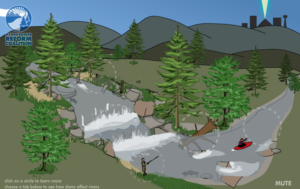Say No to Shasta Dam Raise, Again
The issue of raising Shasta Dam has recirculated, and once again CalTrout remains fervently opposed to raising Shasta Dam and we need your help to stop it. This project is a bad idea for fish, water, and people.
Construction of this water storage project in California would permanently alter the McCloud River, a designated California Wild and Scenic River, violate state law, and destroy Native American sacred sites. Because this project would be both economically and environmentally harmful, we ask our members to tell the Bureau of Reclamation to oppose raising Shasta Dam.
Please send a letter today to the Bureau of Reclamation and tell them you oppose this plan. The comment period closes on September 21st.
The ongoing saga:
- In 2013. CalTrout commented on the BOR’s Shasta Dam Raising Draft Feasibility Report
- In 2018, CalTrout and members helped block a sneaky bill provision that would have fast forwarded the expansion of Shasta Dam
- In 2019, CA Attorney General Xavier Bacerra filed a lawsuit to block Westlands Water District from taking unlawful action to assist in the planning and construction of a project to raise the height of Shasta Dam
- Today, The Bureau of Reclamation has again proposed raising Shasta Dam and is seeking public input on the Shasta Lake Water Resources Investigation Draft Supplemental Environmental Impact Statement. We need your voice to stop this.
Let’s debunk the arguments in favor:
“By raising the 600-foot-tall Shasta Dam by 3% or an additional 18.5 feet, the proposed project would increase water storage capacity in the Shasta Lake reservoir by 634,000 acre-feet or more than 200 billion gallons”
Our response: The actual yield of additional water from an enlarged reservoir is uncertain. As proposed, the 18.5-foot raise would cost $1.3 billion and increase storage by 13%. But that is only under years when the reservoir actually fills. The potential storage doesn’t justify the exorbitant cost AND 100% of that cost will be paid by federal taxpayers.
- While on paper it is true that raising the dam allows for more water storage, it overlooks the fact that nature only provides so much water that is being exacerbated by climate change.
- Projected annual average deliveries will yield just 51,000 acre-feet: a minuscule volume of water when spread across the Central Valley Project. Actual deliveries to farmers and cities would total less than .2% of current agricultural and urban water use statewide.
- The Bureau of Reclamation could raise the dam 100 feet but still fail to improve storage and delivery statewide during 80% of average water years because there is insufficient rainfall and snowmelt to fill the reservoir in all but a handful of years.
- Simply put: building a larger cup to store water doesn’t change how much water we have if the faucet isn’t turned on.
“The dedicated environmental storage from the dam raise would improve water quality in the Sacramento River below the dam by lowering water temperatures for anadromous fish survival, such as Chinook salmon and other fish that migrate from the ocean to rivers to spawn.”
Our response: We don’t buy it. The United States Fish and Wildlife has strongly questioned the Bureau’s claim. The USFWS also noted that “improving the dam’s existing temperature control device, restoring downstream spawning gravel, increasing access to historic floodplain habitat, improving fish passage on tributaries, increasing minimum flows, and screening water diversions all increase salmon survival more than the dam raise.” We agree!
- Federal studies of the proposal concluded that raising the dam would increase the already inundated portion of the lower McCloud River, a designated CA Wild and Scenic River, by more than one-third.
- This further inundation would have a significant negative impact on the river’s unique habitats and blue-ribbon trout fisheries and would submerge sacred sites of the Winnemem Wintu Native American Tribe. Much of the Winnemem Wintu native land was already destroyed by the construction of the original dam in 1945.
The raising of Shasta Dam would further inundate up to three miles of blue-ribbon wild trout fisheries on the Upper Sacramento and McCloud Rivers.
Follow three anglers on a soulful and heartfelt journey into one of America’s premier rivers.
“This is a strategic project that is smart, cost-effective and an environmentally sound investment for California.”
Our response: Existing public information on the project suspiciously omits a clear description of how newly available water would be allocated, sold, and ultimately delivered throughout the state. Why should taxpayers cover the $1.3 billion-dollar expense when the project (1) primarily benefits wealthy water districts in Fresno (2) generates average deliveries of just 51,300 acre-feet, and (3) only delivers water on average 1 out of every 5 years)?
- The biggest beneficiaries of this project likely include special interests such as Westlands Water District in Fresno. According to their website, Westlands serves only 700 families with farms that average 875 acres in size.
- California can do better than spending billions to benefit so few.
More Information
Drew Braugh, “Raising Shasta Dam: Tempting, but Not a Solution.” CalTrout The Current Magazine, Summer 2019
The post Say No to Shasta Dam Raise, Again appeared first on California Trout.


